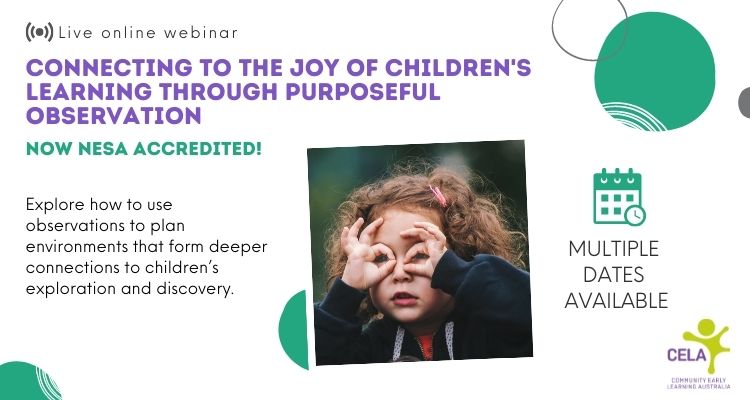Play-based learning forms a central pillar of the Early Years Learning Framework. More specifically, the Framework talks about educators being responsive to children’s play so they can “extend children’s learning via open ended questioning, providing feedback, challenging their thinking and guiding their learning.”1
This is consistent with the principles of guided play, or scaffolding, where child-directed free play is combined with adult guidance or mentorship. Guided play in an early childhood setting takes one of two forms. That is, either educator-designed settings which children can freely explore, or educator observations of child-directed activities.2
Understanding our role in guided play
CELA training facilitator and Nominated Supervisor at the Rumpus Room, Ella de la Motte says that it takes a quality educator to truly understand their role in guiding children’s play.
“The role of the educator is to know the individual children so deeply and connect so beautifully with them that they know exactly what the children need,” she explains. “Some children will need longer periods of time. Some children will need you to step in closer to the experience. Other children will want you to pretend you’re not there. The educator sets up the experience and is present. The children are empowered to own the experience with the educators stepping in as required and stepping back as required.”
Guided play is a purposeful and meaningful tool in early childhood education and care. Macquarie University Researcher, Tanya Burr, says many educators may be more familiar with the term “scaffolding”.
Scaffolding has its roots in Vygotsky’s Zone of Proximal Development (ZPD) — ‘the distance between the actual developmental level as determined by independent problem solving and the level of potential development as determined through problem solving under adult guidance, or in collaboration with more capable peers’ (Vygotsky, 1978, p. 86).
“It’s like building a house,” says Tanya. “We have scaffolding around the house until it can stand by itself. And that’s essentially what educators do. They’re there if the children need them but then it’s about stepping back and letting the child gain ownership of the play where they can really lead with their creativity, their ideas and their agency.”
The neuroscience of guided play, and the importance of relationships
Cognitive neuroscientist Dr Victoria Leong has been studying parents and young children to learn more about the link between social interaction and learning. Her research uses a method called dyadic EEG to look at the neuroscience of social interaction.3 In a study of parent-child pairs, Leong's group found that a state of synchrony occurred when the behaviour of two people was coordinated. This state of synchrony is an important factor in the learning that takes place while two people are playing together.
When a child plays with a partner—an educator in the early childhood setting—their brains synchronise temporarily. Dr Leong also noted that children are more engaged and more likely to learn from the interaction.
Tanya Burr echoes this finding. In her research at Macquarie University, she often asks educators the question: “What is the role of the adult in child’s play?”
“I like to use that question as a provocation for educators to challenge their thinking,” she explains. “I don’t think there’s ever going to be a perfect answer to that question. But a lot of learning in life is relationship based. We learn through our relationships with others. I don’t think the adult role is always needed in children’s learning, but the relationship is.”
Guided play in everyday practice
So, how can we reflect on this research to inform everyday practice?
CELA Learning and Development Specialist Kerrie Maguire says that educators need to ensure how response-able they are in relation to children’s play.
“Guided play can be an important practice when modelling how a material or object can be utilised within the environment,” she explains. “Be aware of when the child cues you into play, know when to stop and pause and when to engage with the child’s explorations and investigations. We need to be mindful not to dominate or over-direct children’s play.”
Whether this research affirms or challenges your thinking, now is an opportunity to think about the connections you make and how responsive and present you are.
Teacher Tom has some inspired things to say about the role of adults in children's play in his article titled Sitting and watching:
When we step back, when we sit, we leave a space that is perfectly conducive to the proper development and education of young children. When we watch, when we listen to what they are communicating, we will understand when, how, and if they need us. And most of the time, all they need from us is to know where we can be found and that we love them.
Further reading:
Tom Hobson via the Teacher Tom blog: Sitting and watching
Ruth Harper via Amplify!: Setting up an open playroom—why it's not about the things
CELA and Simone Smith via Amplify!: Why won't they play with me? - How to promote inclusion in early education settings
Michelle Cuthbertson via Amplify!: The power of secure attachment relationships
Renee Irving Lee via Amplify!: But that's not fair... helping children to understand the difference between fairness and equalit
References:
1. Australian Government Department of Education and Training. Belonging, Being & Becoming. The Early Years Learning Framework For Australia.
2. Deena Skolnick Weisberg, Kathy Hirsh-Pasek, Roberta Michnick Golinkoff, Audrey K. Kittredge, and David Klahr. Guided Play: Principles and Practices. Current Directions in Psychological Science. 2016, Vol. 25(3) 177–182.
3. Eva Amsen. The neuroscience behind playful learning. The Bold. April, 2022.
Professional development relating to this topic:

Find out more
About CELA
Community Early Learning Australia is a not for profit organisation with a focus on amplifying the value of early learning for every child across Australia - representing our members and uniting our sector as a force for quality education and care.